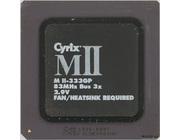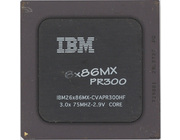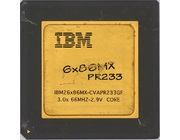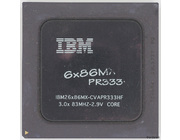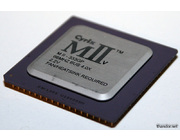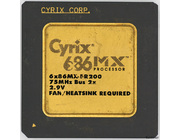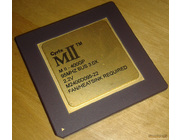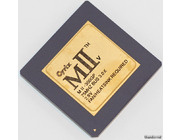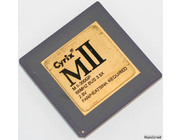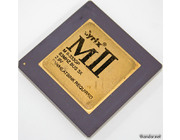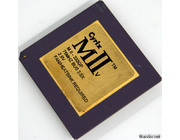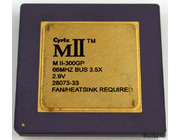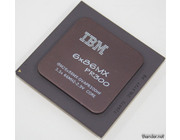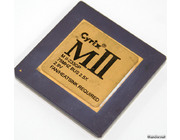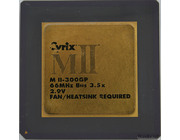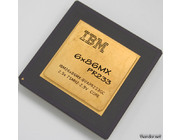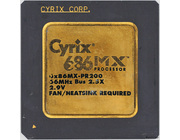The Cyrix 6x86MX PR200 was Cyrix' answer to the Intel Pentium 200. Generally it ran quite well although it ran slightly hotter than the Pentium. For Office use the 6x86 was an excellent choice but for gamers Cyrix left the competition when Quake arrived. The floating-point-unit (FPU) wasn't that strong causing the PR200 to run as fast (or slow) as a Pentium 100.
In European magazines from back in the day the 6x86MX was mentioned in adverts that sold computer parts of whole systems. Usually they sold something like a Pentium MMX 166, 200 and 233 and offered a PR200+ as cheaper alternative.
Also note that the Cyrix 6x86MX PR200 came in two different versions: one with 166MHz/66FSB and one with 150MHz/75FSB. > Read more
This Cyrix MII 333GP came in three versions: one with 66, 75 and 83MHz FSB. This version uses the 83MHz FSB and thus is clocked at 250MHz. The versions with 66 and 75MHz FSB run at 266MHz.
Intel always used 50, 60 and 66MHz busspeeds for their motherboards. Due to dividers the PCI-bus will run within specification (33MHz or slower) if the bus is run at 66MHz or lower. Running at 75 or 83MHz FSB technically falls in the category of overclocking: at 75MHz the PCI-bus runs at 37.5MHz. Increasing the FSB will increase the overall performance of the system. Cyrix used this method to increase the performance of their chips. After all most motherboards can run at least at 75MHz (that is, in the time period of this CPU).
I haven't benchmarked the versions with 66MHz and 75MHz FSB yet. My guess is that the 266/75 combination will the fastest because it has the highest clock frequency and a fairly high FSB. I don't think that the increase to 83MHz FSB (with a lower, 250MHz clock) can make up for the lower clock.
Notice that the print on the chip is a little bit bigger. Cyrix seems to have at least three different sizes for their prints. > Read more
This MII 333GP has a 'V' printed on the CPU. I'm not sure what the V means but it might be because VIA acquired Cyrix by then. > Read more
Just like this 300GP but with an interesting twist: the MII-logo on the CPU is very small! > Read more
Technically this is a Cyrix CPU but IBM sold them under their name as well. I like the dark looking heat spreader that just sits on top of the 'die' (the core). You can look under the heat spreader and actually see the 'die' along with some SMD chips. Somehow that reminds me a lot of the AMD K6-2 (which looks pretty much the same if you remove the heat spreader) especially because the bottom of the CPU is just identical. > Read more
This is the slowest Cyrix MII CPU within the MII-branding. It runs at a fairly low clock frequency but uses a 75MHz bus to speed things up a bit.
The MII ranged from 233GP to 400GP (rated). The 6x86MX actually uses the same chip as the MII but has a different name; they are available in lower speeds.
Cyrix had problems increasing the clock frequencies of the M2-chip. The 333GP runs at either 250 or 266MHz depending on the FSB-speed. The fastest production models are the 400GP and 433GP at 295MHz and 300MHz. Higher frequencies weren't possible within regular voltage and cooling parameters. > Read more
The Cyrix MII was technically exactly the same as a Cyrix 6x86MX; the only thing different was the name!
This CPU only runs at 233MHz and uses a rather slow, but trouble-free, 66MHz bus. The MII-266 uses a 83MHz bus and runs at 208MHz but is faster in some applications.
> Read more
Similar to the Cyrix 6x86MX PR200 but then a tad faster. This one clocks at 187MHz using a 75MHz front-side-bus so it's only 21MHz faster than the PR200 mentioned earlier. Luckily the increased front-side-bus will compensate for the slightly increased clock frequency and increase overall performance after all. > Read more
Cyrix' M2 was, on paper, quite an improvement over the M1R that the IBM 6x86 P200+ used. This because the M2 is made on 350nm instead of 650nm and thus uses a lower core voltage which causes much less heat generation. Despite this, the increased L1 cache (to 64KB instead of 16KB) the results in the benchmarks are not shocking because it still lacks a decent FPU. Doom doesn't seem to fly but the faster the CPU gets, the harder it will be to get a higher score with Doom. The PCI bus and Matrox Millenium 4MB PCI I use for the Doom benchmark is nearing it's limits. It isn't surprising that Doom runs slightly better on the old 6x86 P200+ (M1R) because this CPU uses a 75MHz FSB and 37,5MHz PCI bus.
On the other side: when benchmarking the CPU's in Windows I removed the Pentium MMX 200MHz and installed the Cyrix 6x86MX PR200 and immediately noticed that Windows ran much more smoother. I guess the CPUMark '99 score will represent the performance in Windows quite much ![]() . MDK also seems to run a lot better compared to the 6x86 P200+.
. MDK also seems to run a lot better compared to the 6x86 P200+.
The code on the back of this CPU is GEDD8735H. This stands for
| Code | Explanation |
| G | IBM |
| E | .35u process, 5 layer design |
| D | Burlington, Vt fab. |
| D8 | Die run code 'D8' |
| 7 | 1997 |
| 35 | Week 35 |
| H | Lot code 'H' |
